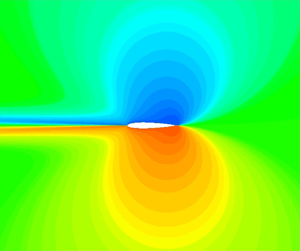Published online by Cambridge University Press: 13 June 2022

The Green's function approach of Giles and Pierce (J. Fluid Mech., vol. 426, 2001, pp. 327–345) is used to build the lift and drag based analytic adjoint solutions for the two-dimensional incompressible Euler equations around irrotational base flows. The drag-based adjoint solution turns out to have a very simple closed form in terms of the flow variables and is smooth throughout the flow domain, while the lift-based solution is singular at rear stagnation points and sharp trailing edges owing to the Kutta condition. This singularity is propagated to the whole dividing streamline (which includes the incoming stagnation streamline and the wall) upstream of the rear singularity (trailing edge or rear stagnation point) by the sensitivity of the Kutta condition to changes in the stagnation pressure.